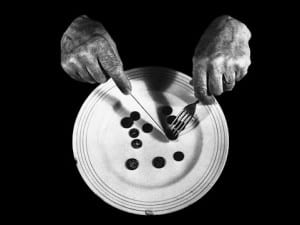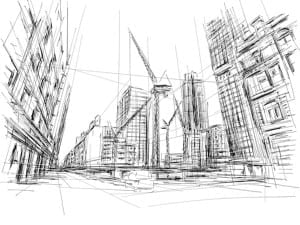Slovenian artist Jasmina Cibic flags up the “soft power” linguistics and aesthetics played forth by politicians and policy-makers in her latest exhibition, This Machine Builds Nations at the BALTIC, Centre for Contemporary Art, in Gateshead. Running until 28 May, the show, which amalgamates films and props from her Nada trilogy, architecturally draws its audience through an intricate web of historical and contemporary references – notably, the landmark buildings of three preeminent 20th century architects.
BALTIC Curator of Exhibitions and Research, Alessandro Vincentelli, speaks about the development of the Nada project from artist film to immersive, theatrical and timely installation – one which queries the misuse of words, culture and the portrayal of women as agents for political “triumph.” Vincentelli was curatorial advisor for the Nada trilogy.
A: This Machine Builds Nations is Jasmina Cibic’s first exhibition at BALTIC. What drew you to commission and curate a site-specific installation of her Nada trilogy?
AV: It was certainly from encountering the work back in 2015, and from understanding the complexity and rigour of Cibic’s research in her earlier series titled Spielraum (2016). I began thinking about how great it would be to stage a presentation of her work at BALTIC, and I started to ask myself whether we could support the development of something new. This led to an extension of the Nada series – the trilogy of which we are now exhibiting.
After interviewing Cibic, seeing her installation at MOCAB Belgrade and then meeting up in London, I gauged that the artist was interested in developing total installations or “Gesamptkunstwerk” that layered together architecture, sculpture, performance and historical research. She inscribed them with entirely new trajectories of the artist’s own making that were clearly coming from both language, the archive, and an interest in where power lies and the rhetoric of speech.
A: Walking through the space, the exhibition interjects visual art, architecture and design with performance and the moving image. How effective is this menagerie of disciplines in depicting the tropes of “soft power”?
AV: It is worth breaking down the various components of the exhibition, because at one level there is a dense layering of ideas in the different works. However it also works and operates visually; it is attractive and enticing. It is brought together, I think, succinctly in the films and in particular in Nada Act III, where the three women are discussing the nature of “the exhibition”. The history of former Yugoslavia and the non-aligned countries were actively involved in different kinds of experiments, where artists worked for the state or were commissioned for a common purpose, Soft Power.
Cibic’s practice is drawn from real archival research and even meticulous translations of key documents, interviews or transcripts of decisive meetings or designs associated with ideas for ways in which artists and architects were enlisted to the work of a new state. Soft Power is a fascinating piece of discourse: rather than coercion or brute force, it is focuses on ideas of attraction to get things done. It is incisive to look at the way art and artists have been used and can indeed still be used in this political “game.”
A: Cibic draws upon imagery and buildings from Yugoslavia, Denmark and Germany. How are these cultural references relevant to a gallery in the North East of England?
AV: BALTIC has followed this work’s journey – as in we have collaborated on commissions and sourced locations together. Nada was planned in three acts with an awareness that we would share in finding resources – both to assist in some of its development and for restaging and presenting it as an exhibition in early 2018. It was more than 18 months ago that the artist first visited the gallery space at BALTIC. Cibic has worked with us on the gallery layouts and the architectural configurations, arriving at the best and most effective way to present the three films associated with the Nada trilogy. They depict remarkable locations which are all associated with stunning modernist architecture. It is great for audiences coming to BALTIC and to Newcastle or Gateshead to see these locations researched and used in this way.
A: In her work, Cibic refers to the misuse of culture in the production of national image. As a curator, is it possible, in your opinion, to tease culture and political rhetoric apart?
AV: The focus on political rhetoric is pertinent for our times as language and its misuse is something that Cibic and other artists are, I believe, right to draw attention to. Phrases and aphorisms used by politicians when talking about culture is often toe-curling. Casual and unthinking language has the potential to do damage in society, indeed even incite others to act. This interrogation of language and the way it operates is considered and allows for a level of complexity and engagement. If we think about a phrase like “Take Back Control” used by British politicians in the Brexit referendum of 2016/17 and a parallel growing intolerance to migrants, you can quite easily see parallels to the ways in which words are deployed in her artworks.
A: The Nada trilogy queries the representation of women as muse, man’s inspiration and Mother Nation. How does this relate to the wider discussion on gender equality, particularly within the arts?
AV: One of the really distinctive ways that Cibic develops her projects is her use of female actors, narrators and performers. They have a role to play in inscribing something new into her research of the archives. There is an interest in a double game, in a play of history and its representation. The female voice is written into these works in a way that allows for new ways of reading the historical archive.
A: What does the BALTIC wish to inspire in its audiences through the presentation of This Machine Builds Nations?
AV: The key thing is the presentation of an artist whose work is deserving of attention. When you know the level of research and meticulous cinematography that goes into these films and installations, it is great to know that a high level of technical presentation was possible to achieve at BALTIC. This Machine Builds Nations, as an exhibition, is cumulative: taken together, it draws in design, architecture and film into an arresting synthesis, or new combinations. It is also a sensory experience, and it has been heartening to see the response from audiences to the exhibition to date.
Jasmina Cibic, This Machine Builds Nations, until 28 May, BALTIC, Centre for Contemporary Art, Gateshead.
Selina Oakes
Credits:
1. Jasmina Cibic NADA Act II 2016 production still.





